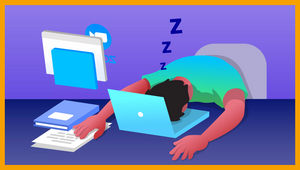After 4+ years Rick Pijnenburg, UX Designer, moved on to a new adventure. Fortunately he left some of his knowledge behind. In his final blog he shares his experience with organizing remote workshops, also known as 'zoom fatique'.
At funda we like to bring all experts together in a room to tackle problems and to brainstorm about potential solutions. We've all participated in a workshop or brainstorm that ended up being a complete energy drainer; so bad that you're eagerly watching the clock until the session ends. I personally even facilitated a few of them myself. Over time I learned a thing or two about how to facilitate remote workshops to be more energetic and efficient.
When you're physically in a room together, it's easy to notice, through body language, when participants are getting distracted, tired or even frustrated, and then to act upon these signals. But recently, we've been doing more and more workshops remotely, making it a lot more difficult to spot if your workshop participants are still paying attention and remain full of energy.
Here, we'll go through some of the pitfalls of a remote workshop, and why they can be so energy sapping. And we will list some tips and tricks that we apply at funda to make our remote workshops more energizing.
We often organize a creative workshop or design sprint at the beginning of a project or when we’re facing a complex challenge, to come up with potential solutions.
For example, we organized a design sprint focused on helping searchers assess a home for sale more quickly on the object page. During this sprint, we came up with multiple potential improvements, some of which made it to production, like the object summary (key object features & direct link to a map) and activity metrics (how often a home is viewed & saved).
But these workshops are not just organized to come up with ideas; they’re also a way to bring the knowledge from all different disciplines together, to create a shared understanding of the context, the opportunities and the risks.
Next to that, they create a sense of ownership of a solution's direction. They tell us when the team came up with the solution, and we get to understand the underlying context it was based on. This is also in line with one of our fundamental beliefs: “Act like an owner”.
Why do remote workshops cost so much energy?
First, we must identify what the challenges are with remote workshops. There are a few things that are different in a remote setting than in person.
Always on, which means distractions
As the participants are always on a device, they're easily distracted by an incoming email or a message on Teams. Combine this with the fact that they often use two screens to effectively join a workshop, and you can understand that there’s a big risk of distractions.
Virtual workspace
Nowadays, we have all the tools to create a digital workshop room, with digital Post-it notes, whiteboards, dot votes etc., but the only way we can control all of them is with our mouse.
An action like clustering some stickies together is quite simple to do in person, with your hands, but in a remote setting, with a virtual room, it takes up significant cognitive load. The same goes for sharing ideas or concepts with drawings. In a 'normal' setting, you sketch something quickly on a Post-it and share it with the group, but in a remote setting you have to digitalize all these steps, which requires a lot of effort.
Also read the blog: 4 reasons why having a mentor at work is a great idea
Sitting all day
Due to the fact that all interactions are virtual, you're often glued to your laptop all day, which also means you're sitting all day. Not only can this be physically tiring and lead to discomfort, but staring at a screen for extended periods of time can lead to eyestrain and headaches, resulting in more fatigue.

How do we improve remote workshops?
We've highlighted the issues with remote workshops and have identified ways of managing energy in general. So how do we apply these learnings in practice, so we can have more engaging and efficient remote workshops?
- Introduce more breaks
The frequency, duration and immediacy of video calls have been proven to directly impact the fatigue of participants. [1] So let's design our workshops in such a way that we can decrease the impact on their energy levels as much as possible.
By including a short break (5-10 min) every hour, to rest your eyes away from the screen for a short period, we allow participants to recharge their energy and focus, and give them the opportunity to get up and move around a bit. [2] Especially in virtual workshops, try to convince your participants to go outside for a while to stretch their legs!
In practice:
- Add a 10 min. break every hour
- Schedule a long lunch break, so participants can go outside - Schedule 'distraction' time
Distractions are not only an issue in virtual workshops, but they happen more often than in in-person workshops. In the latter, you're not constantly looking at your device so you're less prone to get distracted. And if a participant does get distracted, because they need to answer an email for example, they can easily step out of the room for a bit.
According to studies it takes up to 23 minutes to 'get back into the flow' of working on a task after being interrupted. You need to switch your focus to a completely different context and back again. That’s even more the case when you're doing deep thinking work like creative thinking or brainstorming.
So the best thing we can do as a facilitator is to decrease interruptions. We have to schedule dedicated time for distractions in our workshop agenda, and communicate about this upfront, to manage expectations. We can do this for example by starting the workshop an hour later or ending an hour earlier. Also we communicate about these dedicated distraction timeslots beforehand, so that we all agree that we limit distractions during the workshop itself.
In practice:
- Schedule 1 hour of distraction time before or after your workshop
- Ask participants to turn on an out-of-office for the day, or close their chat & email applications temporarily - Split individual & group work where possible
There's nothing more energy sapping than a group brainstorm. It often turns into a small group of participants dominating the session, while the others are passively waiting. Combine this with the challenges of translating your creativity onto virtual whiteboards, in which you're often limited to only using sticky notes, and you have a recipe for disaster.
Especially for deep thinking work, like coming up with ideas or doing some research into analytics, it's often better to work individually. Individually you can focus better and you don't fall into the trap of what is termed 'groupthink'. In a group you often want to agree with each other and you're afraid to stand out, which curtails your creative process.
So as a facilitator, look at your planned workshop exercises and determine if these are better done as a group or individually. In the latter case, participants can work at their own pace, think about their ideas in more detail and then regroup to share their learnings. In a remote setting, individual exercises also have the added benefit that participants can enjoy an extra break from screen time!
In practice:
- Define individual & group exercises in your workshop agenda
- Exit the video call during the individual exercises - Prepare workshop meticulously in advance
This obviously goes without saying, but you have to prepare your workshop beforehand! Set your workshop objective, define exercises and create the agenda (including breaks).
In a remote setting it's even more important to prepare well in advance. You can’t just bring everybody together in a room with some sticky notes and whiteboard markers. You need to set up a collaborative tool, such as a virtual whiteboard in Miro or a shared document, to ensure that participants can work together and share ideas.
It is also important to provide any necessary tools, such as drawing software, and to share all relevant documents well in advance to create shared knowledge among participants.
In practice:
- Share relevant documents upfront in a shared folder
- Set up a virtual whiteboard for each day of your workshop
- Prepare templates for each of the exercises
- Share relevant tools to use during the workshop such as Excalidraw and Miro
Summary
So to wrap it up, organizing an effective and energetic remote workshop requires careful planning and consideration of the challenges that come with working remotely. By introducing more breaks, scheduling distraction time, and splitting individual and group exercises where possible, you can help ensure that your workshop runs smoothly and effectively.
Additionally, it is important to prepare your virtual workshop room well in advance to ensure that all participants have the necessary tools and resources to fully participate.
Hopefully these tips will help you to successfully facilitate your next remote workshop!
Read more at: 5 reasons why we believe in testing our products as a team


